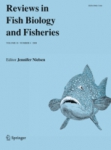Environmental effects on fished lobsters and crabs
Environmental effects on fished lobsters and crabs

In times of climate change, when the sea temperatures are increasing in the world oceans, and ocean acidification is becoming and increasing concern, information of environmental effects on key life history stages of important species is important and needs to be readily available. Lobsters and crabs are key commercial species, and due to their complex life cycle different environmental variable may have dissimilar effects on their abundance, depending on the life stage considered. This review will be very valuable for managers, fishermen as well as scientists alike.
Scientific abstract
The fisheries for crabs and lobsters (Reptantia, Decapoda) are shaped by environmental variation through the distribution ecology, productivity or even their market traits such as colour and size. Many crabs and lobsters have a wide latitudinal distribution and therefore are exposed to significant abiotic gradients throughout their geographic range. Environmental factors affect reptantians throughout their complex life cycle, including embryo development, timing and length of the spawning period, the duration and quality of the larval stages, the level and spatial distribution of the settlement, growth rates and size of the juveniles, size at maturity, and catchability. The most consistent environmental response is of growth and reproduction to temperature. Growth rates increase with increasing temperatures in a parabolic function, tapering and then declining as the boundaries of thermal tolerance are reached. With increasing temperature the intermoult duration decreases. Once the upper thermal boundary is reached, increases in temperature result in longer intermoult duration and smaller growth increments so that growth is reduced. Declines in temperature generally suppress moulting, and consequently reptantians rarely moult in winter. Increasing temperature decreases the time for egg incubation, larval development and the maturational age. Catchability increases with water temperature and also varies, although less predictably, with moon phase and wind strength. Catchability decreases with an increase in population density. Larval settlement of many reptantian species depends on current strength, increasing with the strength of certain local currents. Reptantians can tolerate a wide-variety of conditions and have flexible life-histories to respond to conditions throughout their broad geographic ranges. Information on environmental effects on reptantians not only assists in understanding probable effects of ocean warming and acidification, but also seasonal and interannual changes in fisheries production.
Full reference
